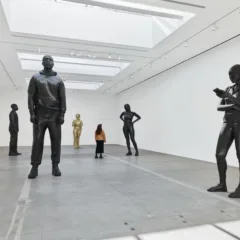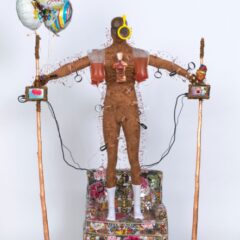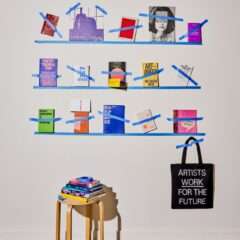Cate and I took a leisurely downtown walk one day late last month and saw one interesting show and one fantastic show. And because we both love it so, we took another walk on the Highline.

Pepon Osorio at Ronald Feldman
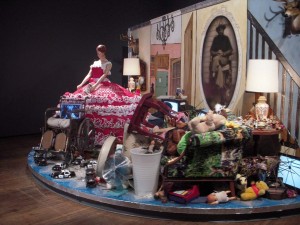
I want to echo Andrea’s enthusiasm for the excellent Pepon Osorio exhibit at Ronald Feldman. (See her post of 9/27/11) What struck me as new is the mechanical action of one gigantic piece that rotates on a slow-moving platform. The whole thing creaks and groans like something from, oh, maybe Shakespeare’s day. Both the accumulation of stuff on the platform and the mechanical torture-rack-wheel-of-fate sounds remind you of the cycle of life and people trapped in their own existence.
Social Media at Pace
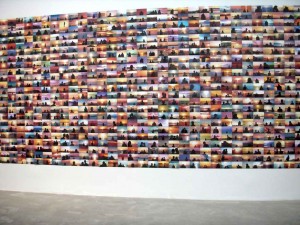
The big group show Social Media at Pace MacGill Gallery on 25th St. has some good moments. Take Penelope Umbrico’s “Sunset Portraits from 9,623,557 Flickr Sunset Pictures on 8/22/11” for example. Umbrico uses the online photo-sharing site — populated by serious photographers (Chuck Patch, Zoe Strauss) but mostly by eager snapshot shooters who want to share — to do some social research. Her results: 1. people love to photograph each other in front of beautiful sunsets; 2. people love to share these photos; 3. the people in the photos are unrecognizable, just black shapes in front of the sunset. 4. bad photos don’t matter to people taking and sharing them; 5. it’s more about the trying than the result. 6. these photos are in a way like tags, like “Kilroy was here” or other grafitti scrawls.
Bad photos make interesting art projects. In fact, Umbrico’s project resembles the non-juried open-call “Snapshot” exhibit that travelled the country and was at Arcadia University Art Gallery in 2001. Umbrico is not making fun of these bad photos (neither did the Snapshot show). She’s saying something about universal human needs to communicate via photographs. Photos are our cave paintings — we truly need to make them. And I guess Flickr — and other photo sharing sites — are the caves.
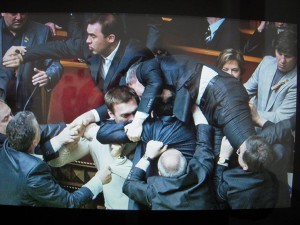
Like Umbrico, David Byrne, in “Democracy in Action,” picked a number of similar images from online sources and arrayed them together in a tight scrum of video picture frames. The images show men in suits who are duly-elected representatives of the people, fighting in their legislative chambers. Again, it’s the universality that’s the focus. Without knowing anyone’s name, these are guys anywhere in the world brawling about stuff that really, really matters to them (whatever that may be). A couple of the images seem — except for the suits and ties — right out of a Romantic era history painting.
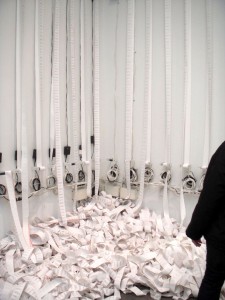
Less thought-provoking are works that use online media to drive 3D works. Christopher Baker’s “Murmer Study” uses emotional Tweets (meh grrr, ewww,hmphh, argh) from the Twitter website and prints them out in real time on thermal printers mounted on the wall. The sheer number of words is, of course, predictable. But when you pick up one of the strands of paper to read it and see how banal the tweets are (and if you’ve spent any time at Twitter this will be no surprise) it’s just plain depressing. So much time spent on so little. No wonder our country’s not producing anything anymore. Everybody’s tweeting, and tweeting junk! If this is the message, it’s now news. Kudos to the artist who programmed the software to pull these live feeds. Maybe next time he’ll pull stuff about the viral nature of re-tweets, which seems to me more fruitful territory…maybe.
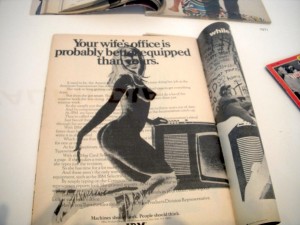
Lots more people in the show, including the early precursor of social media artists, Robert Heinecken (1932-2008) whose display of punked out Time magazines from the 60’s and 70’s in the front lobby is worth studying. Heinecken was highly subversive, inserting his own politically- or sexually-charged remakes of original material into the magazines then slipping them back onto newsstands or into doctor’s waiting rooms. Cate knew all about Heinecken, but this was my introduction, and what he was doing is the equivalent today of hacking a magazine’s website. Pretty interesting.
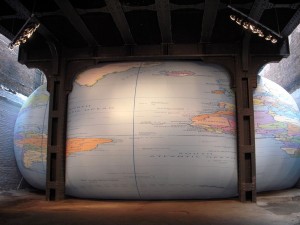
Outside, next to the gallery, David Byrne’s “Tight Spot,” squeezed itself in between two buildings beneath the HighLine. Made of the same material as Macy’s Thanksgiving Parade balloons, the skewed beach ball globe is priced at $200,000, if you want it. The may tweaks the continents and countries and has, for example, an enormous Brazil. When we asked why, the gallery assistant stationed there said it was probably because Byrne goes to Brazil all the time and really loves it there. Tight Spot made a loud, low moaning sound — a cow stuck in a fence comes to mind. Funny. Tight Spot is now down, but Social Media is up through Oct. 15.


